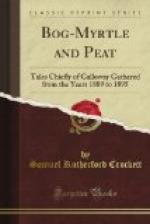Once or twice a surly keeper peremptorily turned back the innocent and law-abiding sex, but always when unaccompanied by the more persistent male. So there was wrath at the table-d’hote. There was indignation in the houses of summer residence scattered up and down the strath. It was the new tenant of the Lodge of Glen Conquhar, or rather his wife, who had done this thing. For the first season for many years the shooting and fishing on the north side of the Conquhar had been let by the Marquis of Rannoch. From the minister’s glebe for ten miles up the water these rights extended. They had been leased to the scion of a Black Country family, noble in the second generation by virtue of the paternal tubs and vats. The master was a shy man, dwelling in gaiters and great boots, only to be met with far on the hills, and then passing placidly on with quiet down-looking eyes. Contrariwise, the lady was much in evidence. Her noble proportions and determined eye made the boldest quail. The M.P. thanked Heaven three times a day that he was not her husband. She managed the house and the shooting as well. Among other things, she had resolved that no more should mere hotel-visitors walk to within sight of her windows, and that the path which led up the north side of the glen must be shut up for ever and ever. She procured a painted board from a cunning artificer in the neighbouring town of Portmore, which announced (quite illegally) the pains and penalties which would overtake those who ventured to set foot on the forbidden roadway.
There were enthusiastic mass meetings, tempered with tea and cake, on the lawn. Ladies said impressive things of their ill-treatment; and their several protectors, and even others without any direct and obvious claim, felt indignation upon their several accounts. The correct theory of trespass was announced by a high authority, and the famous prescription of the great judge, Lord Mouthmore, was stated. It ran as follows:—
“When called to account for trespass, make use of the following formula if you wish the law to have no hold over you: ’I claim no right-of-way, and I offer sixpence in lieu of damages,’ at the same time offering the money composition to the enemy.”
This was thought to be an admirable solution, and all the ladies present resolved to carry sixpences in their pockets when next they went a-walking. One lady so mistrusted her memory that she set down the prescription privately as follows: “I claim no sixpence, and I offer damages in lieu of right-of-way!”
“It is always well to be exact,” she said; “memory is so treacherous.”




